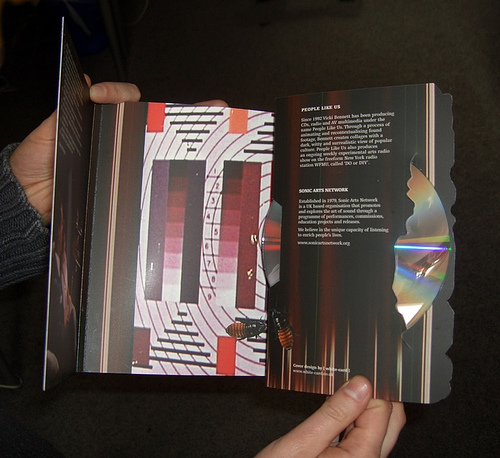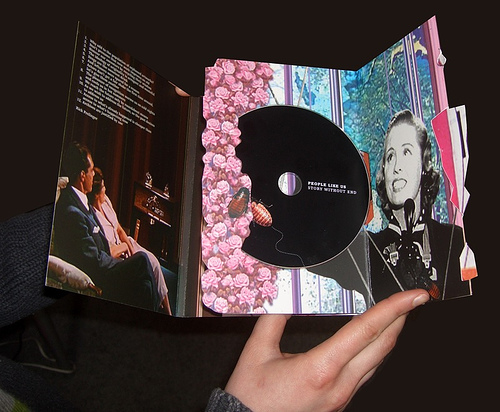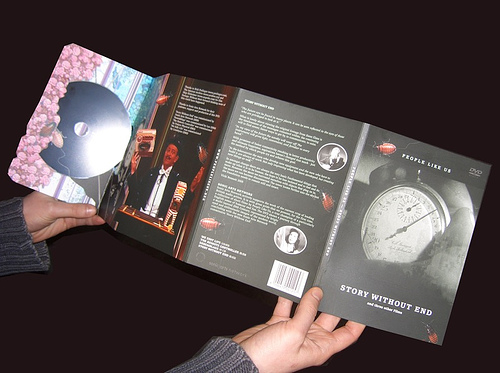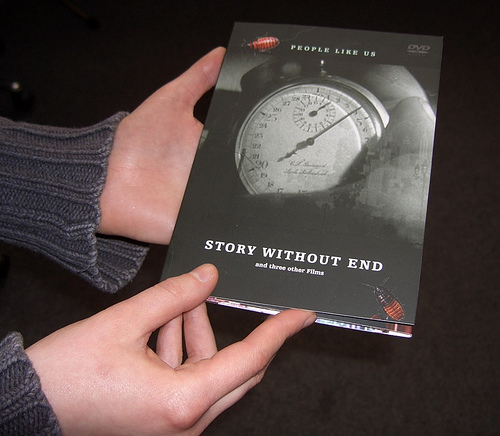Here are some reviews on People Like Us and Friends performing at Ether Festival, Purcell Room, London. Participants for the evening were chosen by Vicki Bennett, based around each performance containing a lot of humour. The advertising made it seem like it was more to do with sampling but this was secondary to the humorous aspect when it came to choosing who would play.
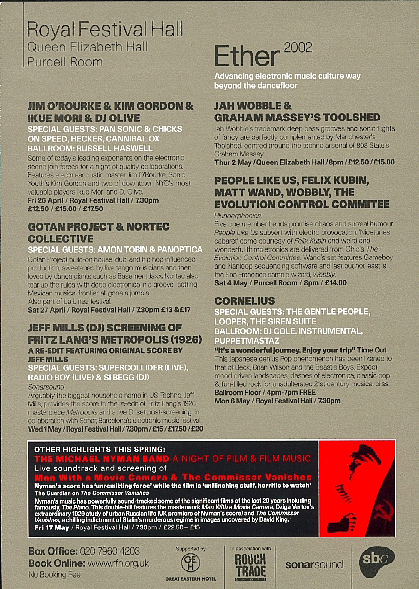
Despite the spike of recent interest in bootlegs, plunderphonia and other sonic ballyhoo, the small Purcell Room was only about half full on Ether’s night of digital disobedience, whose theme seemed decidedly undersold, since the cast included some real scoops for the UK stage. Phthalo/Tigerbeat6 magician Wobbly opened up with a heads down, no-nonsense digital blast zone, strafing and bombing the speakers with deftly processed and mulched samples, with no apparent rules of engagement. Evolution Control Committee’s Mark Gunderson gave a lecture presentation on the ECC’s activities like a Sesame Street presenter on coke’ his homemade thimble-trigger system providing visual stimulus as he refashioned food and drink ads, Public Enemy raps and TV voice-overs into (a)musing infobursts Felix Kubin’s demented, surrealist electro-ditties, accompanied by his charismatic self (Julian Clary meets Marc Bolan as extras in Liquid Sky) on kitsch Hammond organ, provide a deformed other take on the Miss Kittin style electrotainment that’s currently teetering on the mainstream brink. Matt Wand hunched in an easy chair, appropriately, to give a live rendition of some glitchy electronic ruckus on a pair of Gameboys running sequencing programs. But the evening belonged to Vicki Bennett aka People Like Us, whose ‘Recyclopaedia Britannica’ of sound/video mixes just gets better and better. She has locked into a personal editing style where the screen becomes a wide canvas for positioning sampled chunks of ‘where did she find that”‘ video, from weird American TV, government information films, vintage newsreel, patronising documentary and whitebread soap entertainment. Intelligently bringing out, through repetition, the hidden reverse of deceptively innocent bits of film, her tongue in cheek musical pastiches are at their most bitingly incisive as the soundtrack to the films. Don’t miss this great multimedia project as it hits its stride.
Rob Young, The Wire June 2002

Date: Sun, 05 May 2002 08:29:29 +0100
From: Bob Boster
Subject: [rumori] PLU, ECC, Wobbly (and pals) in London
Howdy,
Not enough time to do this show justice, but since I enjoyed the Tonic review so well I feel compelled to at least give it a brief overview.
Last night the Ether (non-dance electronic music) festival of the South Bank left/Royal Festival Hall hosted our stalwarts in the high late modernist style of the Purcell Room. About 200 people were there, possibly a few more. Certainly a crowd like this I’ve never seen at an event in ‘our’ musical community’s dedicated honor. The evening was headed ‘Plunderphonics’.
Wobbly opened. Jon’s set was a rolling, shifting affair with his trademark dense-pack assault as the primary material, sometimes integrating some rhythmic sections, and a couple times dropping away to more atmospheric sections. Travelling light (no keyboard) meant Jon didn’t get into one of his classic ‘song’ things, which was a shame for people who have never seen him before, but the set was so action packed, I’m sure no one else ever missed it.
Some Wild Why fragments here and there, but nothing like the full-on barrage. Some attempts at trainspotting worked for some audience members, but as Jon has gone more and more ‘Plexure-ish’ it doesn’t really give people the time to actually pin it down before he moves on. It’s more like the flavor comes into your mouth and then the next bite goes down before you can name that spice.
Guy next to us was a complete stranger and he was totally on top of everything at each moment, rolling back and forth with the joy of the chaotic stream and occasionally hooting or yelling when a real strong moment hit. It was a pleasure to take that in. Much of the crowd seemed really along for the ride on this somewhat difficult material, but there were the typical 3 or 4 who got overwhelmed after a few minutes and fled.
Next up ECC, my first live experience. Mark is actually talking and doing some schtick as part of the set, which was a good thing (as Jon was mute). His white coveralls, bright ‘mad scientist’ hair, and thimble controllers made a great visual image. I’m sure his deep voice and authoritative American accent worked for the crowd also. After a video opener, he did a somewhat thematic set of thimbletron stuff that worked for the crowd and really entertained.
One thing that worked for me personally was the fact that he sent his laptop graphics up to the video projection so people could see the waveforms (and sometimes make out the file names) of the bits being triggered by the thimble action. This worked to forward the technology into people’s minds without undercutting it by being too recognizable (assume that was custom stuff you wrote Mark…).
Anyway, the dramatic goofiness of the set, the completeness of the whole vision, and the entertaining aspect of the pieces really all worked well. I expected some sniggering at ‘American goofiness’ but didn’t overhear any.
Matt Wand played next. His placement in the set was perfect because he had a physical ‘wired’ quality that bound him to Mark, but what came out of it was totally abstract. Matt played looping sequences of pretty much pure tones from 2 Gameboys. The outcome was a slamming, largely rhythmic but non-dancey wash of this repetitive but always shifting crunchy noise. Nice and relatively minimal processing (although I couldn’t tell what part of the looping process was the gameboys and which was processing until afterwards).
Matt really pushed the show out into to new space by not having any ‘samples’ but the gameboy theme worked with the overview, and the set really rocked. Sort of like riding in a shopping cart down from the continental divide…it never stopped rolling, but the quality of the bumpiness changed every couple seconds.
We were then lucky enough to enter the wild and wonderful world of Felix Kubin. Felix puts an incredibly lovable thing together and it works on sheer innocence and the commitment of his dramatic vision. Arriving in full glam spaceman regalia, Felix came out and promptly announced that he’s not really a plunderphonic artist and proceeded to play a joyful set of SONGS, touching a style list from Trio to digital hardcore to Kraftwerk. To site himself somewhat in the style of the evening, he did a remix of a PLU cut, which worked.
Some songs had vocals. Much of the set had speech in the interstices, which was nice. There was a joyful feel about the whole thing, and somehow the kitsch gave it another link to the rest of the program, which was enough for it to be bound together successfully. His video had a great quality to it, also linking him to PLU’s set.
Someone needs to book Felix on a tour into SF and figure out how to properly promote it so all the possible vectors that would appreciate it show up…amazing live set.
Onto PLU, the headliner. Vicki did a unified set tied up with video. The meshing of the video elements in a style that totally fit into the aesthetic of Vicki’s musical work is a great thing to take in. I’m not sure that someone who comes to it without a background in the recorded work would have this experience with it, but that was really true for me. I saw her do some stuff with video in Chicago a couple years back, but it didn’t hold together like this (of course I also had a terrible site line in Chicago and this projection was glorious). Her aesthetic holds true for the music and the video in the same way, and makes a really powerful combination.
Another thing that worked for me about this set was that somehow really disparate themes and elements ended up holding together in some kind of shattered, surreal narrative. Many of us utilize this effect in audio, by returning to material repeatedly during a performance which seems to somehow bind things together. In this case, Vicki has done the same thing in video, and the quality ends up holding a very scattered set of pieces together into something with a completely coherent aspect. Really interesting, and entertaining. And the sense of following the ‘story’ added something new to the evening, keeping people plugged in even after 4 really strong sets before this one. The migration over to a video-centric presentation also gave the audience some new quality to hang onto.
Vicki was received triumphantly (all acts were, but I think the sense of Vicki as the ‘vision’ behind the line-up was apparent, and that added to her approval as well). Hats off to her, because this was a really significant context and a really great show to fit in it. Hopefully more of these things can be leveraged off this one (not least of which because I’d like a chance to grab an audience like that myself) and help to move London to the forefront of cultural capitals for this kind of music. Vicki’s really got the ball rolling and hopefully I can help push.
, Anyway, that’s all the data that comes to mind (after 5 hours sleep). Off to Paris and Munich (just missing NY and I’d have the M People in my head all weekend).
Any questions?
Your faithful correspondent,
Bob
Date: Tue, 07 May 2002 20:22:37 -0400
From: The Evolution Control Committee
Subject: [Rumori] UK Ether Festival
Just thought I’d jot down some reactions to the Ether festival at London’s South Bank complex (Royal Festival Hall & Purcell Room) and other related things…
First off, the most important portion of it for me (and I suspect most on this list) was the May 4 show at the Purcell Room, featuring Wobbly, The Evolution Control Committee, Matt Wand (of Hot Air and Stock, Hausen and Walkman), Felix Kubin, and People Like Us. 7.30 show, no intermission, 25 minutes for each artist. About 200-ish people thought it was worth paying 14 pounds admission for.
I have to admit my viewpoint was both great and terrible for this show, since I was in it and spent much of the time backstage… however, it does afford behind-the-scenes looks at things such as Felix Kubin sweeping the stage sans trousers.
WOBBLY. I’ve had the pleasure of playing a few shows with him of late, so I’ve seen what he does and have a basis for comparison of this show, and I’d say this was one of the best I’ve witnessed. Great transitions between segments (if you even noticed the transitions at all) of very chopped up stuff. Very thorough edits that only occasionally allow you to detect what the original source material might have been — no doubt left in the mind that it’s been thoroughly changed, altered, recycled, and improved. I only wish the audience could better have seen how Wobbly operates… probably most would assume he’s another laptop composer, except that his face isn’t glowing on-stage from the screen. Indeed, he uses no laptop at all but multiple Dr. Sample-style devices to put his stuff together live, each sample triggered lovingly by hand and tweaked in real time. It’s quite impressive when you can see his dexterity and how he does it, but unfortunately the audience misses out on that treat.
THE ECC. Well, obviously I had the worst view in the house on this one, since I was on-stage for it. I’ll just say that it felt like one of the smoother shows I’ve given and I got great feedback about it.
MATT WAND. Unfortunately I didn’t get to really see or hear his set, except a few brief moments. What little I could hear well sounded pretty interesting and I really wish I could’ve heard more and been out in the audience myself. Audience members I talked to later said that it was a bit plain to watch since the whole set was performed on Gameboys and effects pedals while Matt was seated left stage in a comfy chair. I was really interested in the Gameboy thing; I don’t know much about it, but earlier in the week I did another show where the opening act also performed with a Gameboy (and other instruments)…
FELIX KUBIN. Blew me clean away. Great performer with a great sense of humor that came through perfectly clear even though English is his second language (German is his first, since he’s from Hamburg). Now that I think about it, the night was really perfectly ordered, in that both Felix and ECC were very up-front and performance oriented, and Wobbly, Matt, and PLU were not, so the line-up alternated evenly between more and less “live” performances. Felix played organ/keyboard and synth with some backing tracks, doing songs that really weren’t sample-oriented or “plunderphonic” at all, but still quite enjoyable and memorable. The highlight of the set was a movie which he played the soundtrack for, bringing to mind the new wave sets of Liquid Sky or Dr. Caligari, as well as the cheap-set/high-creativity balance of Forbidden Zone. He packed his 25 minutes to the limit.
PEOPLE LIKE US. Like Wobbly, I’ve had the pleasure of seeing Vicki’s work a number of times over the past year, and each time it just astounds me more. I don’t tend to watch movies or videos more than once because I usually feel like I’ve absorbed all the important parts in one sitting, but the PLU videos always have me asking myself whether a certain bit was new this time or if I just didn’t catch it the first time I saw it. It’s phenomenal stuff, basically surrealist/plagiarist video seamlessly connected and laced together with a soundtrack improvised over the video’s “natural” audio track. Something of a dadaist, apolitical Emergency Broadcast Network or something. It’s a tired buzzword, but as far as a “multimedia” performance goes this is it — full video, great sound, holds your attention completely from start to finish. The great pity of it all is… there’s no way to see any of it outside of a live show! Save for one DVD compilation with one bit on it, I don’t think any of the video is available. But you might just want to view it as a live-only thing — you can’t see/experience live shows in your home, so just accept the video component as a live-only thing. Like Felix, a really dense 25 minutes, though I think I noticed that she cheated and went over. Good. 🙂
Overall, an impressive night on all accounts. Honestly, when the definitive guide to plagiarhythmic history is finally written, this should really be one for the books. I felt like everyone was in fine form and this was a rare and talented lineup. Kudos to all those that made this happen, especially Glenn Max, Jane Beese, Kirsten, Joana, and doubly especially Vicki for bringing us all together for this!




